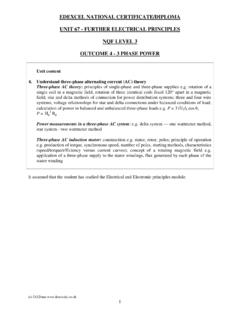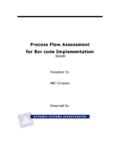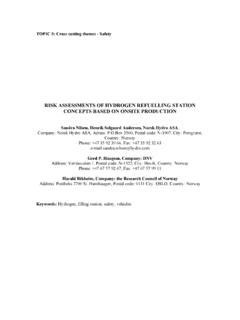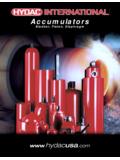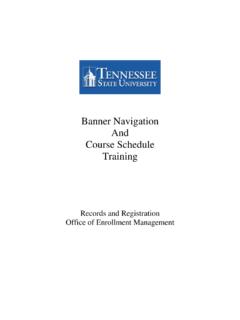Transcription of UNIT 61: ENGINEERING THERMODYNAMICS - FREE …
1 1 unit 61: ENGINEERING THERMODYNAMICS unit code : D/601/1410 QCF level: 5 Credit value: 15 OUTCOME 4 STEAM AND GAS TURBINE POWER PLANT TUTORIAL No. 8 STEAM CYCLES 4 Understand the operation of steam and gas turbine power plant Principles of operation: impulse and reaction turbines; condensing; pass-out and back pressure steam turbines; single and double shaft gas turbines; regeneration and re-heat in gas turbines; combined heat and power plants Circuit and property diagrams: circuit diagrams to show boiler/heat exchanger; superheater; turbine; condenser; condenser cooling water circuit; hot well; economiser/feedwater heater; condensate extraction and boiler feed pumps; temperature entropy diagram of Rankine cycle Performance characteristics: Carnot, Rankine and actual cycle efficiencies.
2 Turbine isentropic efficiency; power output; use of property tables and enthalpy-entropy diagram for steam When you have completed tutorial 8 you should be able to do the following. Explain the Carnot steam cycle. Explain the Rankine steam power cycle. Describe improvements to the Rankine cycle. 2 1. STEAM CYCLES THE CARNOT STEAM CYCLE In previous tutorials you learned that a Carnot cycle gave the highest thermal efficiency possible for an engine working between two temperatures. The cycle consisted of isothermal heating and cooling and reversible adiabatic expansion and compression. Consider a cycle that uses vapour throughout.
3 Evaporation and condensation at constant pressure is also constant temperature. Isothermal heating and cooling is theoretically possible. The cycle would consist of the same 4 processes as before only this time each process would be carried out in a separate steady flow plant item with the vapour flowing from one to the other in a closed loop as shown below. Fig. 1 The four processes are: 1 - 2 Evaporation at constant pressure and temperature requiring heat input. 2 - 3 Reversible adiabatic expansion in the turbine giving power output. 3 - 4 Cooling and condensing at constant pressure and temperature in the condenser requiring heat output.
4 4 - 1 Reversible adiabatic compression requiring power input. In order that no temperature changes occur in the evaporator and condenser, the vapour must be wet at inlet and outlet. Over-cooling will produce liquid at temperatures below the saturation temperature and over-heating will superheat it beyond the saturation temperature. The cycle will be a rectangle on the T-s diagram and as shown on the h-s diagram. 3 The limits are that at point (2) it may be dry saturated vapour but not superheated. At point 1 it may be saturated water but not under-cooled. If these limits are not used, then the vapour has a dryness fraction at each point.
5 Since heat transfer only occurs at the evaporator and condenser the heat transfer rates are given by the following expressions. in = m(h2 - h1) = Th S (Boiler) out = m(h3 - h4) = Tc S (Condenser) Th is the boiler temperature and Tc is the condenser temperature. The thermal efficiency may be found from the 1st. Law. th= 1 - out / in = 1 - Tc / Th This expression is the same as for the gas version. WORKED EXAMPLE No. 1 A Carnot cycle is conducted on steam as follows. The evaporator produces dry saturated steam at 10 bar. The steam is expanded reversibly and adiabatically in a turbine to 1 bar. The exhaust steam is partially condensed and then compressed back to 10 bar.
6 As a result of the compression, the wet steam is changed completely into saturated water. Assuming a flow rate of 1 kg/s throughout determine the condition and specific enthalpy at each point in the cycle. Calculate the energy transfers for each stage. Show that the efficiency is correctly predicted by the expression th= T(cold)/T(hot) 4 SOLUTION We will refer to the previous diagrams throughout. EVAPORATOR h2 = hg at 10 bar (since it is dry saturated) = 2778 kJ/kg. s2 = sg at 10 bar (since it is dry saturated) = kJ/kg K. h1 = hf at 10 bar (since it is saturated water) = 763 kJ/kg. in = 1 (2778 - 763) = 2015 kW TURBINE Since the expansion is isentropic then s2= s3 = kJ/kg K s3 = = sf + x3sfg at 1 bar = + x3( ) hence x3= h3 = hf + x3hfg at 1 bar = 417 + ( )(2258) = 2387 kJ/kg P(output) = 1(2778 - 2387) = kW COMPRESSOR Since the compression is isentropic then s4= s1 s1 = sf at 10 bar (since it is saturated water) = kJ/kg K.
7 S4 = s1 = = sf + x4sfg at 1 bar = + x4( ) hence x4 = h4 = hf + x4hfg at 1 bar = 417 + ( )(2258) = kJ/kg Power Input = 1(763 - ) = kW CONDENSER Heat output = 1(2387 - ) = kW Energy Balances rounded off to nearest kW. Total energy input = + 2015 = 2050 kW Total energy output = + = 2050 kW Net Power output = - = 356 kW Net Heat input = 2015 - = 356 kW Thermal efficiency = Pnett/ in = 356/2015 = Thermal Efficiency = 1 - out / in = 1 - = The hottest temperature in the cycle is ts at 10 bar = oC or K The coldest temperature in the cycle is ts at 1 bar = oC or K The Carnot efficiency = 1 - = 5 SELF ASSESSMENT EXERCISE 1.
8 A steam power plant uses the Carnot cycle. The boiler puts 25 kW of heat into the cycle and produces wet steam at 300oC. The condenser produces wet steam at 50oC. Calculate the following. i. The efficiency of the plant. ( ) ii. The net power output. ( kW) iii. The heat removed by the condenser. (14 kW) 2. A steam power plant is based on the Carnot cycle. The boiler is supplied with saturated water at 20 bar and produces dry saturated steam at 20 bar. The condenser operates at bar. Assuming a mass flow rate of 1 kg/s calculate the following. i. The thermal efficiency. ( ) ii. The power output of the turbine. (792 kW) iii.
9 The heat transfer rate into the boiler. ( MW) 6 THE RANKINE CYCLE The Rankine Cycle is a practical cycle and most steam power plants are based on it. The problems with the Carnot Cycle are as follows. It produces only small net power outputs for the plant size because dry saturated steam is used at inlet to the turbine. It is impractical to compress wet steam because the water content separates out and fills the compressor. It is impractical to control the condenser to produce wet steam of the correct dryness fraction. In order to get around these problems, the Rankine Cycle uses superheated steam from the boiler to the turbine.
10 The condenser completely condenses the exhaust steam into saturated water. The compressor is replaced with a water (feed) pump to return the water to the boiler. The result of this is reduced efficiency but greater quantities of power. The plant layout is shown above. First let s briefly examine the boiler. 7 BOILER For reasons of combustion efficiency (which you do not have to study), a practical boiler is made up of three sections. a) Economiser This is a water heater inside the boiler that raises the water temperature at the boiler pressure to just below the saturation temperature at that pressure. b) Evaporator This is a unit usually consisting of a drum and tubes in which the water is evaporated and the steam driven off.









